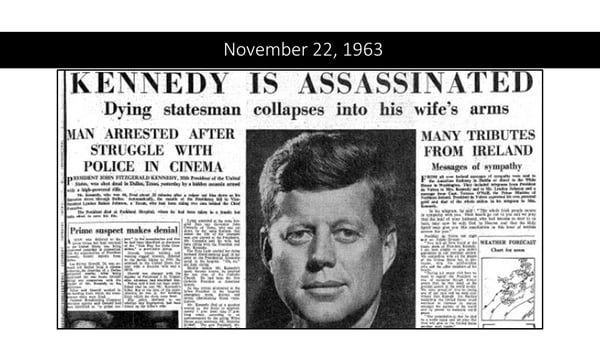What are the steps in strategic planning?
Strategic planning demands a fundamentally different mindset than day-to-day management. While managers excel at solving immediate problems through...

Raise your hand if you were alive on November 22, 1963.
I recently posed this question to 30 senior executives and board members as we opened a jam-packed strategic planning session.
This organization faced a challenge many face today: How to engage more diversity in their thinking.
This was not a new challenge for this organization. They had worked at it. The room had a mix of genders, ages, races, and backgrounds recruited in recent years.
I knew from comments made during the pre-session interviews that there was still a barrier between being invited to the table and engaging once at that table.
I had seen this before. Even with the most earnest recruitment efforts, and the best efforts to make planning sessions safe, people hold back in large strategic thinking forums. It is an intimidating environment, and unfortunately, it favors those more experienced.
As I tucked into my comfy hotel bed the night before, I felt fully prepared but uneasy. This group had a highly admired and long-standing leadership team and an impressive board of directors. In fact, the two most senior staff members had been with the organization for 40 years. Surely they would be on a beach or living next to their kids in another 10 years (this strategic plan time frame).
My role was to help shape strategic thinking for their future. These discussions should be balanced with the wisdom of those who had brought the organization to this point and with insights from those who would be leading it in the future. How do I create an environment in which the next wave of leaders in the room feels authorized to take an active role in strategy development alongside those more seasoned?
This question lingered as I lay my weary head on the pillow and cajoled my brain into switching off.
At 4 am I woke with a new strategy session exercise that might work. Early the next morning, I scoured the internet for an image to mark a moment all would know.
As we started the session, before presenting my customary context-setting module on how strategic planning differs from problem-solving, I asked everyone to stand up and clicked on this slide.

Many in the room groaned in sad remembrance, and others looked puzzled.
You could see a question on their faces: Was this going to be a history lesson?
With everyone standing, I asked, “By a show of hands, how many of you were alive on this date?”
A little more than half the room raised their hands. I asked all with raised hands to sit down.
I asked those still standing to look around at the others standing.
As they looked into each other’s eyes, I said, “You are the future leaders. These strategic planning meetings are about the future, about what you will be leading. Now is your time to shape your thinking about that future. Those of us seated are here to help develop this thinking and to build a plan that will be successful. But make no mistake; you will be called upon in whole or in part to lead it. Take today as an opportunity to start shaping your future leadership.”
There was silence, and then a few standing started to laugh. I said, “So, are you ready?”
The whole group broke out in laughter and applause. They were ready.
Did it work?
Many times during that day, younger leaders took the floor to express themselves. When they did, I noticed greater attention to their words and more clarifying questions asked to deepen the understanding of the meaning behind their words. There were also a few times when the speaker was asked to provide examples so the listener could better appreciate their experience.
I also noticed the group testing a new language. When they used it incorrectly, they were gently corrected, and then celebrated when used correctly. This demonstrated active listening to new concepts or ways of thinking and encouraged even more dialogue.
At a break, the board chair approached me to tell me she loved the exercise. It reinforced her goal to have an open and dynamic strategy session. She also stated that she appreciated the message for those seated. They needed to make room for the voices of the next generation of leaders.
I am writing this post as we look ahead to the new year and as we are experiencing generational leadership changes on a global level.
Bridging the gap between these generations will require each of us to embrace alternative views, learn new terms, and find new ways to create connections. It will call us to embrace new ways of building tomorrow’s strategic thinking capabilities.
At your next long-range planning meeting, invite greater diversity and then authorize their participation with an active demonstration of why they are in the room. Invite them to stand up and then take a seat so they can see themselves as tomorrow’s leaders.

Strategic planning demands a fundamentally different mindset than day-to-day management. While managers excel at solving immediate problems through...

Are you doing well but see others expanding quickly through new partnerships and alliances? Do you see a new business opportunity to expand, but you...

You put so much effort into your beautiful new strategic direction. It is well crafted; you were able to effectively engage multiple stakeholder...